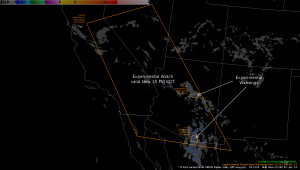The inaugural Hazardous Weather Testbed Hydrology (HWT-Hydro) experiment began today at the National Weather Center in Norman OK. This experiment will explore uses of the FLASH suite of flash flood and heavy rainfall products. Participants will be asked to use these products to issue experimental flash flood watches and warnings; these will include information about the likelihood or uncertainty of a given impact as well as the severity of expected impacts. Novel sources of flash flood observations, including the mPING mobile application and SHAVE phone calls, will be used to assess the effectiveness of the experimental tools and the experimental watches and warnings.
Two forecasters a week are participating in the experiment, with funding provided by the US Weather Research Program. This week’s forecasters are Mike Moneypenny (NWS Forecast Office Raleigh NC) and David Ondrejik (NWS Middle Atlantic River Forecast Center). Joining them are guests Chris Legro (NWS Forecast Office Gray ME) and Jonathan Brazzell (NWS Forecast Office Lake Charles LA).
Each day of the experiment will begin with a weather briefing from the Flash Flood and Intense Rainfall Experiment at the NCEP Weather Prediction Center in College Park MD. Then forecasters will spend time evaluating the performance of the experimental forecast tools and observations from the previous day’s shift. Forecasters will then issue flash flood watches and warnings as necessary, typically from 3 PM to 8 PM CDT, Monday through Thursday. This “virtual forecast office” will cover the entire Lower 48.
Today’s areas of focus can be broadly divided into three main components: the summer monsoon in the Desert Southwest, a complex of strong to severe convection in the middle Mississippi River and Ohio River valleys, and rain across the Middle Atlantic into the Northeast. As I type, our forecasters have already issued an experimental watch and two experimental warnings for afternoon storms in the Southwest (see below for these experimental products overlaid on state/national boundaries and 6-hr MRMS rainfall estimates). More frequent updates can be found by following the experiment on Twitter at @HWTHydro.

